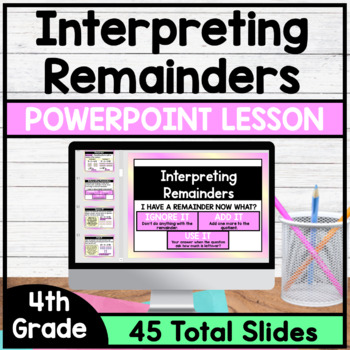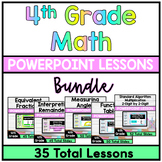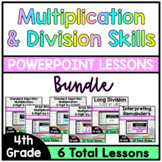Long Division - Interpreting Remainders - PowerPoint Lesson
- Zip
What educators are saying
Also included in
- This is a Bundle of my collection of my 4th Grade Math PowerPoint Lessons. These lessons cover a variety of 4th Grade Math Skills. *These PowerPoint Lessons have everything you need to teach a lesson. Just download and begin teaching, These lessons include Direct Instruction Slides, Guided PracticePrice $110.00Original Price $157.00Save $47.00
- This a Bundle of my collection of PowerPoint Lessons that focus on Multiplication and Division Skills. These PowerPoint Lessons have everything you need to teach a lesson. Simply download and begin teaching! Each PowerPoint Lesson has lots of practice questions and visual models that will help creatPrice $18.00Original Price $27.00Save $9.00
Description
This product is a PowerPoint Lesson that focuses Interpreting Remainders in Long Division Word Problems. The PowerPoint lesson goes through the complete lesson plan cycle. In this lesson students will learn how to interpret remainders in long division problems. Students will learn to when to add one to the quotient, when to ignore the remainder and when to know that the remainder is the answer to the problem.
*This PowerPoint Lesson has everything you need to teach a lesson. Just download and teach! This lesson includes Direct Instruction Slides, Guided Practice Slides and Independent Practice Slides. (Printable Version of Guided Practice Questions and Independent Questions is Included in this Product)
*No need to create your lesson this PowerPoint is a full lesson ready to use!
What's Included?
1.) Direct Instruction Slides – These slides include hook, learning objective, essential questions, vocabulary slides, visual examples of concept slides, 6 practice questions teaching slides.
2.) Guided Practice Question Slides – 8 Total Interactive Guided Practice Questions
3.) Independent Practice Question Slides – 10 Total Interactive Independent Questions
4.) Blank Template Slides – This gives you the option to create your own questions.
5.) Interpreting Remainders Anchor Chart
6.) Printable Version of Guided and Independent Practice Questions
COMMON CORE AND TEKS ALIGNED RESOURCE
CCSS - 4.NBT.B.6 - Find whole-number quotients and remainders with up to four-digit dividends and one-digit divisors, using strategies based on place value, the properties of operations, and/or the relationship between multiplication and division. Illustrate and explain the calculation by using equations, rectangular arrays, and/or area models
TEKS 4.4H - Solve with fluency one‐ and two‐step problems involving multiplication and division, including interpreting remainders
TEKS 4.4F - Use strategies and algorithms, including the standard algorithm, to divide up to a four‐ digit dividend by a one‐digit divisor
To get NEW updates on Math and Science Resources!







